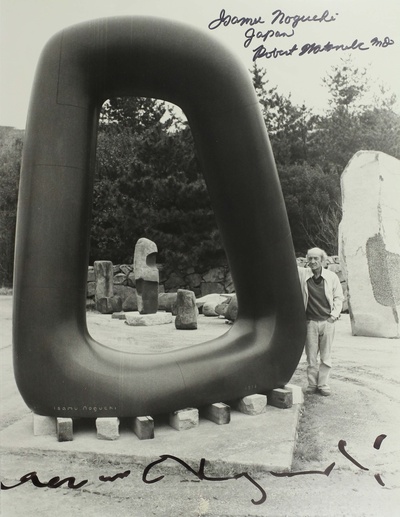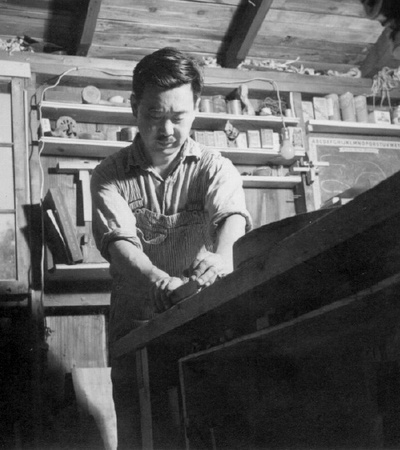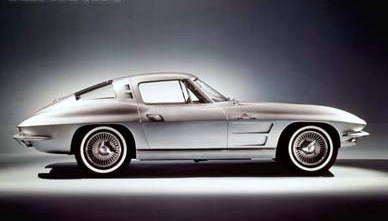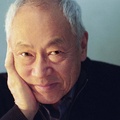As the introductory text to “Self-Interned, 1942: Noguchi in Poston War Relocation Center” is careful to note, Noguchi’s wartime experience was unusual. Like Yamasaki, he was officially living in New York City when Roosevelt signed the executive order, though he had been working on the West Coast. After Pearl Harbor, he had joined the group Nisei Writers and Artists Mobilization for Democracy, trying to prevent incarceration; when that effort proved futile, he decided the best way to help Japanese Americans would be to improve the camps.
In Washington, D.C. he met with John Collier, commissioner of what was then known as the Office of Indian Affairs, who had jurisdiction over the largest camp, at Poston, in Arizona Indian territory. They discussed making the camp into a model community, where the interned would have access to schools, recreation facilities, and classes in traditional Japanese arts and crafts.
The exhibition, which is divided into sections on Noguchi’s work before, during, and after his seven months in camp, includes a pair of measured architectural drawings. One is for a camp cemetery, intended to give the Issei (Japanese immigrant) detainees a proper place to bury their dead. The other is for a linear dream city, with a laundry list of amenities including a zoo, a botanical garden, miniature golf, and a department store. A Japanese garden, drawn at the extreme end of the plan, includes the amoeboid paths and level changes he would later use in his UNESCO Garden of Peace in Paris.
The drawings are surrounded by letters Noguchi wrote from camp, tracing an arc from idealism to frustration to get-me-out despair. Initially enamored of the desert landscape—“I became the leader of forays into the desert to find ironwood roots for sculpting”—Noguchi soon found himself coping with the 100-plus-degree heat, the sickening food, and a lack of common understanding with the other internees, who tended to regard him as allied with their captors.

The administrators of the camp, by contrast, treated him as just another Japanese American, except that he was given a solo space in a barrack. He applied for the materials to create a carpentry and woodcarving shop, kilns for a ceramics studio, equipment to make adobe brick to build an art center, none of which were forthcoming. After a couple of months, in frustration, he turned his efforts to getting out, shifting his artistic focus back to making his own sculpture out of ironwood and away from fellow internees.
Noguchi was given a furlough on November 12, 1942, among many school- and work-age internees who, with the support of aid organizations, schools, sponsors, and employers, were able to free themselves from incarceration by going east—in his case, back to New York.
* * * * *
Had Noguchi been better able to connect with the younger, hybrid generations at Poston, he might have found kindred spirits. In the 1992 catalog for the exhibit “The View from Within: Japanese American Art from the Internment Camps, 1942-1945,” playwright Wakako Yamauchi writes of her family’s internment at Poston:
There were lines for everything: for mail, shots, at the pharmacy and clinic, at the mess halls. There were lines for toilets, showers, and laundry tubs. Everything was communal. No secret was safe…
But in the spirit of shikataganai or “making the best of it,” we bounced back. We formed softball teams and played intramural games. We produced talent shows. We set up libraries, beauty shops, cooperatives, flower and sewing classes, art and drama departments, dug swimming holes and so on, and boy scouts continued to march with Old Glory fluttering high.
This is not to suggest that there was no protest over the camps. The week of the first exclusion order in March 1942, three protesters presented themselves at a police station in Portland, OR, in order to test the constitutionality of the detention of American citizens. One protester, Fred Korematsu, pursued a case that would go all the way to the Supreme Court, which ruled 6-3 that protecting the nation from espionage was more pressing than individual rights. There were strikes at Poston and Manzanar in 1942 and unrest at Tule Lake and Heart Mountain during the four years most of the camps were open.
Making the best of it also included altering the very landscape of the camps. In his oral history at the Cultural Landscape Foundation, landscape architect Joseph Yamada notes that the internees made bonsai and vegetables flower in the desert.
You know, we’re out in the middle of the desert with nothing. They would dump you out there and they’d say, “OK, do your own thing.” They [the Japanese] helped the government install irrigation because they wanted to grow a lot of their own vegetables. They grew the best watermelons, cantaloupes, and vegetables.
The government would deliver greens to the mess hall for their quota. And the Japanese cooks would look at that stuff, [and call it] garbage, because their lettuce, celery, and bell peppers, and everything that they grew in the camp was so far superior to what was being given to us by the government.
Gardening was a profession open to many recent immigrants from farming backgrounds, and one could argue that Japanese aesthetics may first have become mainstream in the U.S. via landscape architecture. In the postwar era, modern landscape architecture was led by men like Hideo Sasaki, Joseph Yamada, and Satoru Nishita, all of whom were interned. Yamada reports on internees’ successful efforts to build a school and a swimming pool, to green the desert and make their own adobe bricks. Noguchi was not the only one seeking ironwood in the harsh climate and turning it into sculpture.
Sasaki was an architecture student at Berkeley in 1942, and his studies were interrupted by the war, to be resumed later at the University of Illinois and then Harvard. Anticipating a need, and understanding how his architecture skills might be useful, he set up a sign shop in the camp and brought in others with even better lettering skills. Later, to escape detention, he volunteered to top sugar beets in Colorado, drawing from childhood experience on his parents’ truck farm. Though he spoke little about the experience, Melanie Simo’s history of the Sasaki offices notes that “the significance of those years was not in the content of the work, but in the resourcefulness, the organizational and management skills, the determination to better his condition, and the acceptance of hard work, nearly continuous work from morning until night, both on the job and, whenever possible, at school as well.”
Resourcefulness didn’t extend only to architecture and earthworks. Automotive designer Larry Shinoda was always car-obsessed, sketching them on paper as a child and drag racing as a teenager. When his family was interned at Manzanar, one of the few possessions he packed was a sketchbook. On their first day in the minimally furnished barracks, he spotted wooden crates behind the latrines. From them, he fashioned reclining chairs for his mother and grandmother ideally (and ergonomically) suited to their small stature.
After he was released, he briefly attended ArtCenter College of Design, then decamped for Detroit, where he was known for drafting skills and his ability to make cars look “fast”—among them the Corvette Stingray. His citation for the Corvette Hall of Fame reads: “The Sting Ray literally set the world on its ear. Few American cars were so instantly recognizable, so clean, and so pure.”
Designer and woodworker George Nakashima, interned with his wife and six-month-old daughter at Minidoka, in Idaho, used the time to study traditional Japanese craftsmanship with master carpenter Gentaro Hikogawa, an internee who had immigrated from Shikoku to Tacoma. He went further than Shinoda, designing a model apartment in the simple barracks out of scrap lumber, the walls covered with wallpaper fashioned out of recycled blueprints.
Eventually, the architect Antonin Raymond and others petitioned the WRA to free Nakashima from Minidoka, and he relocated to New Hope, Pennsylvania. Nakashima and others resettled before the end of the war had to “secure an outside sponsor, furnish proof of employment or education, and submit themselves to FBI background checks.” They were allowed to move to the Midwestern or Eastern United States to live in a white community—in this case, rural New Hope, where the Raymonds had property.
Cold War propaganda hastened (as we saw in the Yamasaki features) to reabsorb Japanese American talent into an assimilated, just-American narrative, and Japanese American cultural norms, which focused on not complaining and looking ahead, contributed to the glossing over of internees’ experiences. Tomoko Miho, who, while working for George Nelson for 12 years, designed graphics and advertising for Herman Miller, said of her time at the camp in Gila River, Arizona, “In order to recover, we had to excel. The experience forced many Japanese Americans to seek new horizons.”
In her 2015 essay, “‘Successful’ Nisei: Politics of Representation and the Cold War American Way of Life,” Sanae Nakatani writes, “The image of the Japanese Americans being successful in the white-dominated American art and architectural fields—the fields that were often associated with the freedom of expression and democracy—served the U.S. greatly to create the self-image of a racially tolerant and culturally plural society.” Nakatani looks specifically at the way the home lives of Yamasaki, Noguchi, and Nakashima were portrayed in the popular press, accounts that stressed their assimilation and presented the designers as part of “typical” American families.

She notes that the WRA photos show the Nakashima family as a model of assimilated domesticity, with photographs taken in 1945 of the family and friends sitting by a stone fireplace using a suite of furniture made by George. Nakashima “has set up a workshop and is designing and making furniture for Hans Knoll, Associates, a wholesale furniture firm in New York City, and making pieces for individual customers and for his own use.”

Ray Komai, a graphic designer best known for his one-piece molded plywood side chair, which won a Museum of Modern Art “Good Design” Award in 1950, was just a few years out of Manzanar when he created the chair, as well as the striking “Masks” fabric for Laverne Originals. War Relocation Authority photographs of Komai, taken in 1944, present his resettlement in the most chipper terms, as if no disruption had occurred. He works for a “leading New York advertising agency,” while his wife works in a cosmetics shop; “while in Manzanar [he] worked as a designer in the industrial division.”
An image of the couple playing bridge with friends at home notes that Kikuyo Masuda is “of Los Angeles and Granada” and Joe Imai is “of Portland, Oregon, and Tule Lake,” tying their biographies to the camps where they were interned, but without specifying the reason for their move. Komai was an associate art director at Architectural Forum from 1953 to 1961, and designed many covers, including an oft-reproduced one from May 1960 showing Ludwig Mies van der Rohe’s Lafayette Park in Detroit, a symbol of postwar integrated housing.
Nakashima, sponsored by Raymond and offered work in New Hope, spent only a year in internment. Other postwar designers, teenagers when they arrived, spent longer in camp, receiving an education first from other internees and then via scholarships to universities willing to accept Japanese Americans.
*This article was originally published by Curbed.com on January 31, 2017.
Curbed © 2017 Vox Media, Inc.






